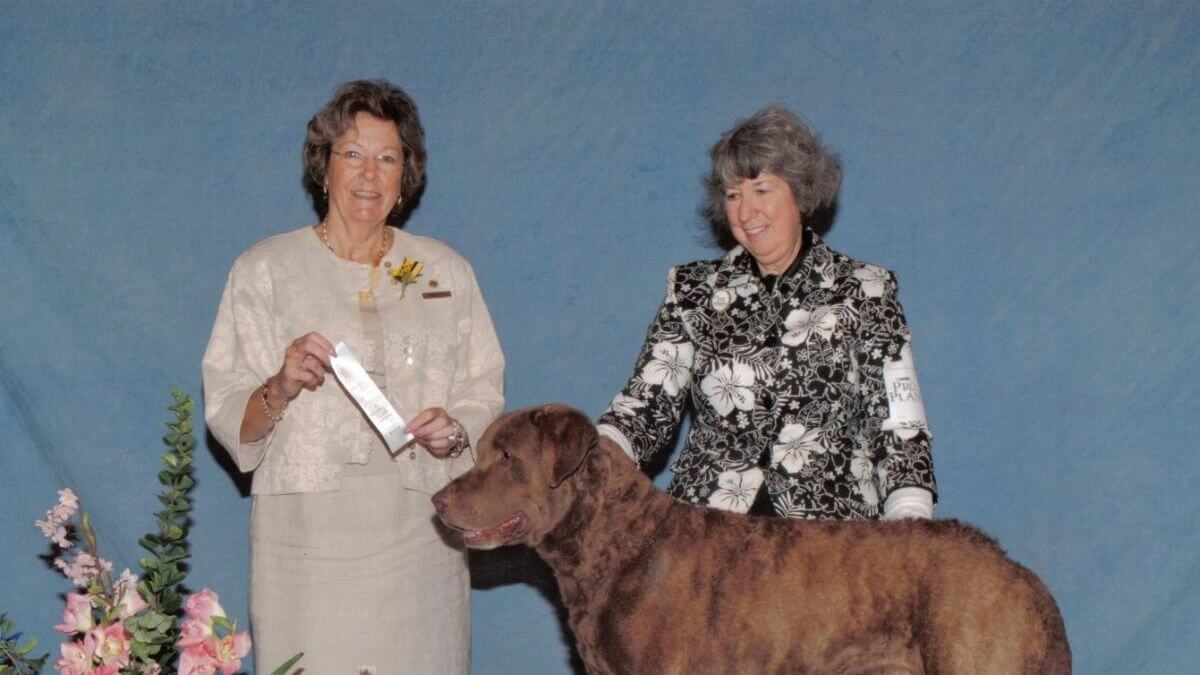


Home » Judging the Chesapeake Bay Retriever

This article was originally published in Showsight Magazine, March 2014 issue.
First impressions are important. When a class of Chesapeake Bay Retrievers enter the ring, the first thing I look at is the outline and proportions. From the side, the head planes should be parallel and the length of the muzzle should be the same length as the backskull. (Although it is not specified in the breed standard, it is accepted by most judges and breeders that head planes should be parallel.) The neck should be close to the same length as the head from nose to occiput. As you move further along the dog, the elbow should be underneath the shoulder, displaying good layback. The shoulder and upper arm should balance each other and be the same length. There should be full liberty of movement. The back should be short and well-coupled and the body is of medium length, not cobby.
The topline is unique when comparing it to other retriever breeds. The hindquarters may be a “trifle higher” than the shoulders. This topline is found in the majority of the breed, although it may also be level. The topline should not be so extreme that it appears as sway-backed. As you approach the flanks, the underline shows a hollowness which may be termed “tuck-up”. Continuing to the hindquarters, legs should be of medium length demonstrating power as they move. There should be well-angulated stifles to match the forequarters. Front and rear legs should be straight when viewed from the front and rear. Ideally, the tail should be carried so that it is straight, without curl, and no higher than 2:00-3:00 p.m. on a clock(!).
By now you have seen the dog from the side and will have the class gait around the ring. As you watch the dogs gait, you are looking for balance and reach and drive — especially a strong rear so that the dog can perform as a good swimming dog. He should be able to move with agility and strength. He should be strong and well-muscled but not coarse. He should demonstrate power and have a good return stroke as the legs come together under the body.
As you approach the dog from the front, quickly ascertain that the eyes are of “yellowish or amber hue”. Amber includes gold, orange and light brownish shades. Many breeders prefer that the eyes blend with the coat because the appearance results in more camouflage in hunting situations. Eye color is a distinctive feature of the breed. Eyes are to be medium large. It is accepted by most breeders that eye shape is oval and not round. The oval shape offers more protection from elements in the field. Ears are small and set up high on the head above eye level to keep them out of the water when swimming. They are to hang loose. The skull is broad and round with jaws capable of carrying large birds. The muzzle is tapered, but not sharp. It is not snipey, but it is also not short. Length is needed to pick up large waterfowl and other birds when hunting. Lips are not pendulous with loose flews, but should be trim so that water does not easily flow into the dog’s mouth when working in the water. Loose flews could also retain feathers. A scissors bite is preferred, but a level bite is acceptable. Overshot and undershot bites are a disqualification.
Now you are ready to examine the dog’s coat, which is a double coat. You see and touch the coat—it should be short, dense and thick. The outercoat should be harsh and should not be longer than 1½ inches. The coat should feel as if there is a “spring” to it and should be examined closely for the undercoat which is soft and wooly. The coat should fit the dog like a jacket and should be presented naturally. It should not be backbrushed and puffed up. The harsh outercoat and the dense undercoat will protect the swimming dog but not if it is blow-dried to stand up away from the dog’s body. The colors are varied and may be any shade of brown from light brown to dark brown, all shades of deadgrass (light blonde to straw-colored) and sedge (reddish-tones). There are many shades of deadgrass which may result in striping, masking or hound markings.
A recessive gene may result in a diluted brown referred to as “ash”. “Any color of brown, sedge or deadgrass is acceptable, selfcolored being preferred. A self-colored dog is one with shades of the colors listed. White is permissible as “a white spot on the breast, belly, toes or back of feet (immediately above the large pad)… the smaller the spot the better, solid colored preferred.” The term “solid-colored” means—without white. A disqualification applies to white markings located in places other than those mentioned above. The coat should be wavy —not straight or curly. There are types of coats with different amounts of wave. The wave may have a crinkled appearance, but the coat is not curly. A coat that is curly would be described as the ringlets one finds in a Curly-coated Retriever. The wave is not important—the texture is, although it is possible that a tighter wave may result in a drier dog. There must be sufficient coat to keep the dog dry when he is doing what he was bred to do. The coat is a hallmark of the breed and relates to his function.
A “black-colored” dog is a disqualification. Such a dog is black all over or black with white patches. It is genetically impossible for a purebred Chesapeake to have black coloring. Do not be distracted by dark hairs that appear in a coat. They are not black. They are dark brown and are part of an acceptable color. There is also a disqualification for a curly coat or a tendency to curl all over the body. In addition, feathering on the tail may not be over 1¾” long.
On examining the dog closely you can also check on his conditioning and amount of muscle and substance. His pasterns should be slightly bent for flexibility. His chest should reach to his elbows. Some younger dogs may not show the depth of brisket. Check the underline in a heavily coated dog. As you move to the rear, check length of hock. In the Chesapeake, the hock is medium as opposed to a short hock. It provides leverage and more speed. The stifles should be well-angulated and show as much power as the forequarters (shoulders sloping with full liberty of action). The hare foot (in which the two center digits are appreciably longer than the outside and inside toes of the foot) also provides more leverage and enables the dog to balance and have better traction on muddy banks.
There is a great variation in size with males from 23″-26″ and females from 21″- 24″. There is no preferred size—all are acceptable. We see very few 23″ males or 21″ females. There is also a specified weight range of 65-80 lbs. for males and 55-70 lbs. for females. These are “working weights” for dogs that are doing what they were bred to do. The Chesapeake is a moderate sized dog and should remain within standard so that he can serve as a hunting dog, sitting in a duck boat. There are various types of hunting scenarios from a dog retrieving smaller upland game such as woodcock or dove to retrieving Canadian or Snow Geese while breaking through the ice.
When each dog is gaited individually you should look for “smooth, free and effortless, giving the impression of great power and strength.” The dog should not be so heavily overdone so that movement is affected and becomes cloddy. The word “medium” is used 14 times in the breed standard. Remember that the Chesapeake is a moderate dog and should not look as if they belong in the working group with physical attributes of a Bull Mastiff or Newfoundland. The dog should move straight coming and going. As speed increases, feet tend to converge towards the center. As the dog is moving away, you should see pads on the hind feet. Common faults are dogs who are out at the elbows or you may see cowhocks in rear movement.
The temperament of the Chesapeake is described as a “bright and happy disposition, intelligence, quiet good sense, and affectionate protective nature.: It is not always easy to see these traits in a dog show ring. Many tend to be reserved and are not outgoing. They are quiet, but usually are quite willing to please their owners and handlers. Chesapeakes are very bonded to their owners and families.
Current faults in our breed are:
The highlights or hallmarks of our breed are the harsh double coat, a distinctive outline, the head with a rounded topskull and small ears set up high on the head, amber or yellow eyes and hare feet. These qualities set the Chesapeake apart from the other retrievers. The breed has greatly improved in coat, gait and soundness and also in temperament.
Because we do have what can be described as “kennel types or styles” (where one kennel may be known for producing excellent coats, and another kennel produces very sound dogs, and a third produces “type-y” heads). You may find that in the entry more of one particular style is represented than other styles.. It may be that the most correct dog is outnumbered by other “styles”. Just because he is in the minority, it does not mean that he is wrong.
The Chesapeake Bay Retriever is the only retriever breed which is still able to earn a Dual Championship: FC/CH (Field Champion/Bench Championship). The standard emphasizes form and function. When you are judging this breed—“the question of coat and general type of balance takes precedence… The Chesapeake should be a well-proportioned animal with a good coat and well balanced in other points rather than excelling in some areas and being weak in others. The dog you choose should be able to do the job he was bred to do.
